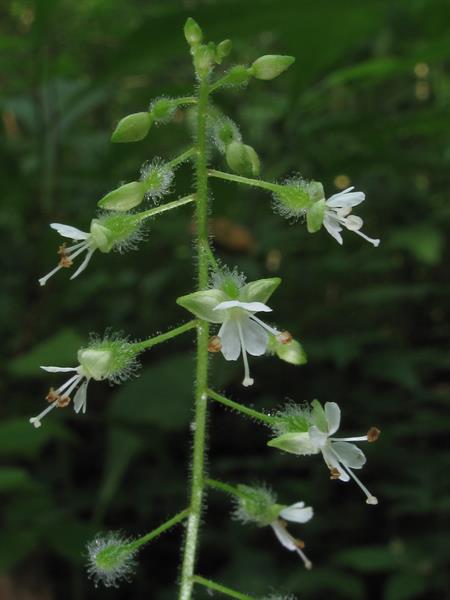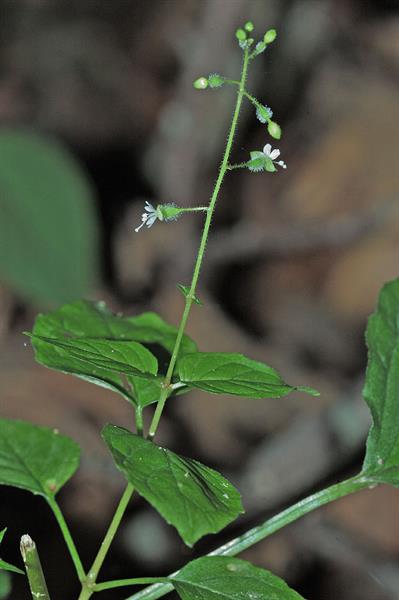
Origin/Endemic status: Native
Taxonomy Comments: The systematics of this taxon has been controversial, and treatments have changed over the years. Most recently, Xie et al. (2009) support species status for C. canadensis, a conclusion followed here. Previously, Boufford (2005) treated the complex as two species, C. canadensis and C. lutetiana, the former with two subspecies, ssp. canadensis of eastern North America and ssp. quadrisulcata of Asia. Before that, Boufford (1983) treated the complex as a circumboreal complex of three subspecies of C. lutetiana, including the North American ssp. canadensis (Linnaeus) Ascherson & Magnus, the primarily Asian ssp. quadrisulcata (Maximowicz) Ascherson & Magnus, and the European ssp. lutetiana. Other authors have preferred varietal status for the three entities, full species status, no formal status at all (C. lutetiana as a polymorphic complex), or associating the more similar pair (North American and Asian) as two subspecies separate from the European at specific rank. Boufford (1983) and Averett & Boufford (1985) show convincingly that separate taxonomic status for the three entities is warranted, and that ssp. canadensis is more closely related to ssp. quadrisulcata. The question of the appropriate taxonomic level remains. Boufford (1983) states that "although subspp. canadensis and quadrisulcata are placed in C. lutetiana, this might not ultimately prove to be the best treatment". Later, flavonoid data showed strong differences between the three taxa, stronger than the differences between many of the other species in the genus (Averett & Boufford 1985). Morphologic differences between the three taxa are fairly subtle but appear to be consistent. The complicated synonymy is perhaps an example of a too-zealous attempt to have nomenclature reflect subtleties of relationship and evolutionary divergence, our understanding of which is unclear and changeable.
Synonymy: = K3, K4, NY, Xie et al (2009); = Circaea canadensis (L.) Hill ssp. canadensis – Ar, Mi, NE, Pa, Va, Boufford (2005), Wagner, Hoch, & Raven (2007); = Circaea latifolia Hill – S; = Circaea lutetiana L. ssp. canadensis (L.) Asch. & Magnus – FNA10, GrPl, Il, K1, RAB, Tn, W, Boufford (1983 [1982]), Munz (1965); = Circaea lutetiana L. var. canadensis L. – C; = Circaea quadrisulcata (Maxim.) Franch. & Sav. ssp. canadensis (L.) Á.Löve & D.Löve; = Circaea quadrisulcata (Maxim.) Franch. & Sav. var. canadensis (L.) Hara – G, Tat, Tx, WV; > Circaea canadensis (L.) Hill var. canadensis – F; > Circaea canadensis (L.) Hill var. virginiana Fernald – F; < Circaea lutetiana L. – S13; > Circaea quadrisulcata (Maxim.) Franch. & Sav. var. canadensis (L.) Hara – F
Wetland Indicator Status:
- Atlantic and Gulf Coastal Plain: FACU (taxonomic split from wetland indicator species)
- Eastern Mountains and Piedmont: FACU (taxonomic split from wetland indicator species)
- Great Plains: FACU (taxonomic split from wetland indicator species)
- Midwest: FACU (taxonomic split from wetland indicator species)
- Northcentral & Northeast: FACU (taxonomic split from wetland indicator species)
Heliophily: 3
Hover over a shape, letter, icon, or arrow on the map for definition or see the legend.
 © Alan M. Cressler | Original Image ⭷
© Alan M. Cressler | Original Image ⭷ © Gary P. Fleming | Original Image ⭷
© Gary P. Fleming | Original Image ⭷ © Erik Danielson source | Original Image ⭷
© Erik Danielson source | Original Image ⭷ © Radford, Ahles and Bell | Original Image ⭷
© Radford, Ahles and Bell | Original Image ⭷Feedback
See something wrong or missing on about Circaea canadensis? Let us know here: (Please include your name and email if at all complicated so we can clarify if needed.)
Cite as...